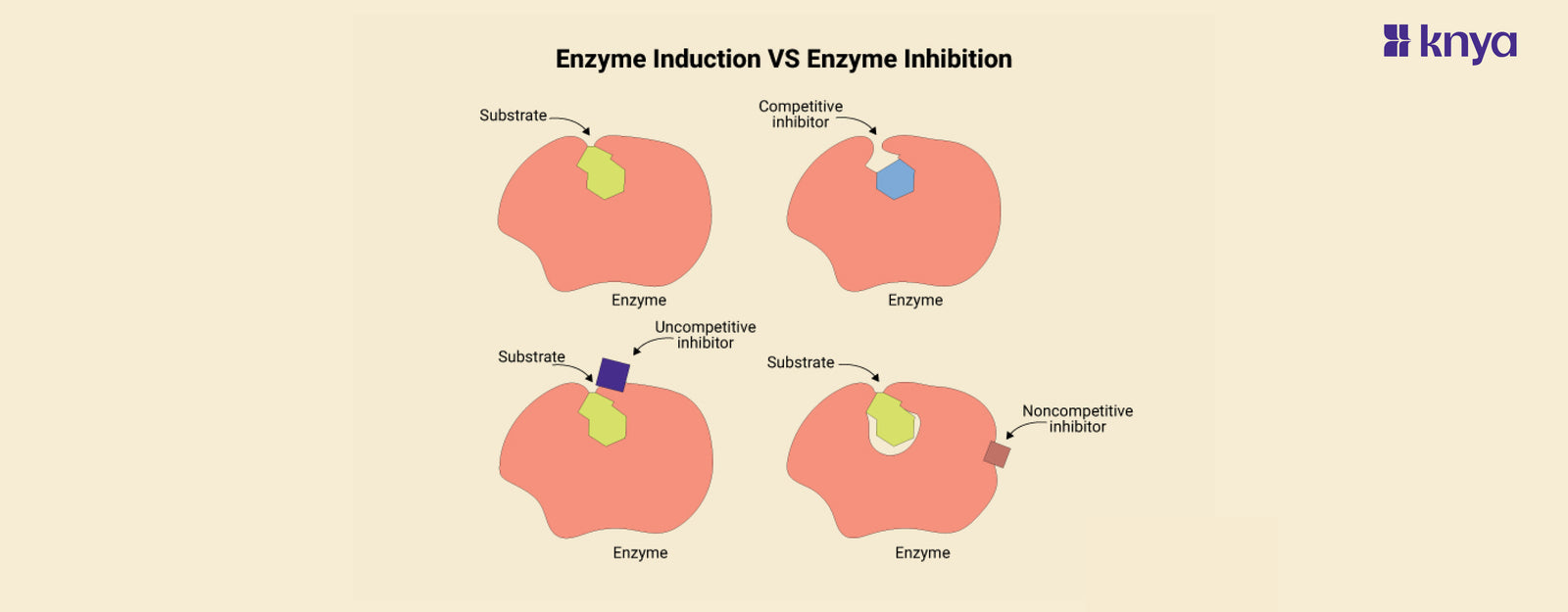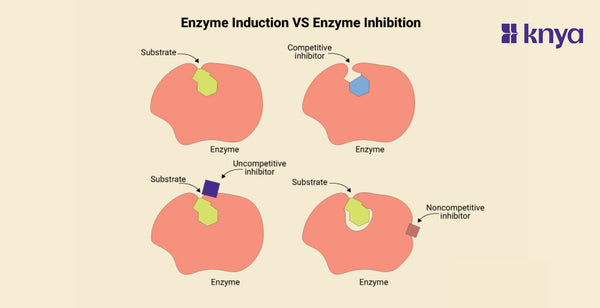Difference Between Enzyme Induction and Enzyme Inhibition: Understanding the intricate mechanisms regulating enzymatic activity is crucial in comprehending how substances interact with biological systems. Enzyme induction and enzyme inhibition are two fundamental concepts that play pivotal roles in the regulation of enzymatic processes. These phenomena involve the modulation of enzyme activity, influencing the rate at which biochemical reactions occur within living organisms. Here are key difference between enzyme induction and enzyme inhibition:
Difference Between Enzyme Induction and Enzyme Inhibition
|
Feature |
Enzyme Induction |
Enzyme Inhibition |
|
Definition |
Process increasing enzyme synthesis in response to specific substances |
Process slowing down or preventing enzymatic activity by the binding of an inhibitor |
|
Effect on Enzyme Activity |
Increases enzyme activity over time |
Decreases or prevents enzyme activity |
|
Regulation Mechanism |
Upregulation of gene expression, leading to increased enzyme synthesis |
Binding of an inhibitor molecule to the enzyme |
|
Time Course of Action |
Usually requires a longer time for effects to manifest |
Can exert effects rapidly, depending on inhibitor concentration and affinity |
|
Reversibility |
Generally reversible; enzyme synthesis returns to baseline if inducer is removed |
Can be reversible or irreversible, depending on the nature of the inhibitor |
|
Binding Site |
N/A |
Competitive (active site) or non-competitive (allosteric site) |
|
Purpose in Living Organisms |
Allows adaptation to changing environmental conditions by increasing enzyme production |
Affects regulatory processes, provides control over metabolic pathways |
|
Examples |
Induction of drug-metabolizing enzymes in the liver in response to certain drugs |
Inhibition of bacterial cell wall synthesis by antibiotics |
|
Application in Pharmacology |
Relevant in drug metabolism and interactions with pharmaceuticals |
Exploited in drug design for therapeutic purposes, designing selective inhibitors |
|
Simultaneous Occurrence |
Can occur simultaneously with other regulatory mechanisms |
Both processes can coexist in a biological system, influencing overall enzymatic activity |
What is Enzyme Induction?
Enzyme induction is a biological process wherein the synthesis of enzymes is increased in response to the presence of specific substances, leading to an enhancement in catalytic activity. This phenomenon is a regulatory mechanism that allows living organisms to adapt to changing environmental conditions, particularly in response to the presence of certain chemicals or substrates.
Key features of enzyme induction include:
- Upregulation of Gene Expression:
- Enzyme induction involves the upregulation of specific genes responsible for encoding enzymes. This process occurs at the level of gene transcription, leading to an increased synthesis of messenger RNA (mRNA) for the relevant enzymes.
- Adaptation to Environmental Changes:
- Organisms induce enzymes as a response to changes in their surroundings. For example, in the liver, certain drugs or xenobiotics may induce the synthesis of enzymes involved in drug metabolism as a protective mechanism.
- Time Course of Action:
- Enzyme induction often requires a longer time to manifest its effects compared to other regulatory mechanisms. The increased synthesis of enzymes and subsequent translation into functional proteins take time.
- Reversibility:
- Enzyme induction is generally a reversible process. If the inducing agent is removed or the environmental conditions change, the level of enzyme synthesis can return to baseline.
- Examples in Physiology:
- In the context of physiology, enzyme induction is commonly observed in the liver. The liver can induce the synthesis of drug-metabolizing enzymes, such as cytochrome P450 enzymes, in response to the presence of certain drugs or foreign substances.
- Role in Drug Metabolism:
- Enzyme induction is a crucial factor in drug metabolism. Some drugs, known as enzyme inducers, can stimulate the synthesis of drug-metabolizing enzymes in the liver, potentially leading to changes in the metabolism and clearance of other drugs.
Understanding enzyme induction is important in fields such as pharmacology, toxicology, and molecular biology, as it sheds light on how organisms adapt to their environment and process various substances. This knowledge is particularly relevant in drug development and the study of metabolic pathways.
What is Enzyme Inhibition?
Enzyme inhibition is a biological process in which the activity of an enzyme is slowed down or prevented by the binding of a molecule (the inhibitor) to the enzyme. This interaction interferes with the normal functioning of the enzyme, either by blocking its active site, altering its conformation, or impeding its ability to interact with substrates. Enzyme inhibition is a crucial regulatory mechanism in various physiological processes and is also exploited in pharmacology for designing therapeutic drugs.
Key features of enzyme inhibition include:
- Binding to the Active Site:
- In competitive inhibition, the inhibitor binds to the active site of the enzyme, preventing the substrate from binding and initiating the enzymatic reaction.
- Allosteric Inhibition:
- Some inhibitors bind to a location other than the active site, causing a conformational change in the enzyme (allosteric inhibition) that reduces its activity.
- Reversibility:
- Enzyme inhibition can be reversible or irreversible. Reversible inhibition is characterized by a temporary interaction between the inhibitor and the enzyme, allowing the enzyme to regain activity once the inhibitor is removed. Irreversible inhibition involves a permanent alteration of the enzyme structure.
- Time Course of Action:
- In contrast to enzyme induction, enzyme inhibition can exert its effects rapidly. The degree of inhibition depends on the concentration of the inhibitor and its affinity for the enzyme.
- Examples in Pharmacology:
- Many drugs exert their effects through enzyme inhibition. For instance, certain antibiotics inhibit enzymes essential for bacterial cell wall synthesis, leading to bacterial cell death.
- Therapeutic Applications:
- Enzyme inhibition is utilized in pharmacology to design drugs that selectively inhibit specific enzymes. These drugs can be used to treat various medical conditions by modulating enzymatic activity.
- Competitive and Non-competitive Inhibition:
- In competitive inhibition, the inhibitor competes with the substrate for binding to the active site. In non-competitive inhibition, the inhibitor binds to a site other than the active site, altering the enzyme's conformation and reducing its activity.
Understanding enzyme inhibition is essential for developing therapeutic interventions, studying metabolic pathways, and elucidating the regulatory mechanisms within living organisms. It provides insights into how certain substances can modulate enzymatic activity, impacting physiological processes and influencing the design of drugs for various medical purposes.
Similarity Between Enzyme Induction and Enzyme Inhibition
Enzyme induction and enzyme inhibition are both phenomena that involve the modulation of enzymatic activity, but they have opposite effects on the rate of enzymatic reactions. Here are some similarities between enzyme induction and enzyme inhibition:
- Regulation of Enzyme Activity:
- Both enzyme induction and enzyme inhibition involve mechanisms that regulate the activity of enzymes.
- Effect on Enzyme Function:
- They both influence the rate of enzymatic reactions, either by increasing (induction) or decreasing (inhibition) enzyme activity.
- Physiological Impact:
- Both processes play crucial roles in physiological and biochemical pathways within living organisms.
- Reversible Nature:
- Enzyme inhibition and some forms of enzyme induction can be reversible. That is, the effect on enzyme activity can be temporary and may be altered by changing the conditions.
- Pharmacological Significance:
- Both processes have pharmacological significance and are targeted in the development of drugs and medications.
- Involvement in Metabolism:
- Enzyme induction and inhibition are often associated with metabolic pathways, where they can regulate the production or breakdown of various substances.
- Interactions with Substrates:
- Both processes involve interactions with substrates or other molecules that affect the enzyme's ability to catalyze a specific reaction.
|
Check out More Articles |
|















